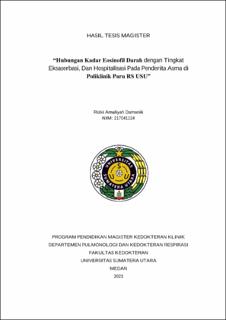| dc.description.abstract | Background: Asthma is a heterogeneous disease, usually characterized by chronic
airway inflammation. According to the World Health Organization (WHO) and the
Global Initiative for Asthma (GINA), there are 300 million people with asthma in
the world, and this number is expected to grow to 400 million by 2025. In patients
with asthma on medication, the severity of asthma is assessed based on the clinical
features of asthma and the treatment regimen. According to the Global Initiative for
Asthma (GINA), asthma management guidelines aim to achieve controlled asthma.
However, in reality, the guidelines are not implemented effectively in daily practice
so that there are still many uncontrolled asthma conditions. Inflammation that
occurs in asthma is a typical inflammation that is accompanied by eosinophil
infiltration, this is what distinguishes asthma from other airway inflammatory
disorders.
Objective To determine the relationship between blood eosinophil levels with the
level of exacerbation and hospitalization in asthma patients at the USU Hospital
Pulmonary Polyclinic.
Methods: This study is a type of analytic observational research with a
retrospective cohort approach, without intervening in research subjects. The
research will try to look backward (backward looking), see the cause of the effects
that have been found. Total sample 25 patients
Results: Based on the results of the study, it can be seen that the age of asthma
patients is mostly in the age category 26-50 years as many as 11 patients (44%).
Based on the results of the study, it can be seen that patients with eusinophil levels
<100 are the most patients, namely 21 people (84%). Based on the results of the
study, it is known that asthma patients with severe exacerbation levels were 18
people (72%). Based on the results of the study, it is known that asthma patients
with uncontrolled asthma tightness are 10 people (40%). Based on the results of the
study it is known that asthma patients who did not receive hospitalization were 18
people (72%). Based on the results of the study obtained a P value of 0.976, because
the P value is greater than 0.05, there is no relationship between eosinophil levels
and the exacerbation rate of asthma patients. | en_US |


